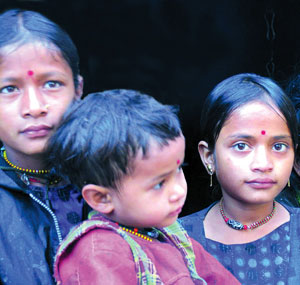 KUNDA DIXIT |
In our obsession with dead-end politics, a news item last week on the shocking surge in female foeticide in Nepal went barely noticed. The investigative report by Ramji Dahal in our sister publication Himal Khabarpatrika delved into how the legalisation of abortion five years ago has led to the proliferation of ultrasound clinics across the country allowing parents to terminate pregnancies if they are girls.
The legislation was passed to give women a choice, to reduce Nepal's appalling maternal mortality rate, and to stop the practice of relatives accusing young daughters-in-law of abortion just to put them behind bars. The law has benefited tens of thousands of women across Nepal, and freed many innocent unjustly jailed women. But as abortion became easier, it has resulted in the appalling spread of female foeticide.
Activists estimate that 50,000 unborn babies are aborted in Nepal every year after parents find out through ultrasound scans that they are girls. This does not include abortions carried out without parents knowing the gender of their babies, half of which are likely also girls.
The slaughter of daughters is the result of deeply-rooted patriarchal values, a preference for boys in many Nepali cultures, a belief that sons are needed to perpetuate the family lineage, the need to pay dowry to marry daughters, and the reluctance to allow daughters to inherit property. This is largely an urban middle-class phenomenon across South Asia, and it is so entrenched that despite the spread of education and gender awareness, old habits die hard.
The discrimination against girls in Nepal now starts even before they are born. As they grow up, many girl children are stigmatised within families and by society: discouraged from going to school, fed last, not taken to hospitals if they fall sick, married off young, denied citizenship, abused or trafficked, sometimes by their own relatives.
This is why, while women live longer than men in most developed countries, the ratio of men to women in Nepal is skewed at 1.04 to 1. In his well-known research paper, Amartya Sen calculated that the preference for sons in China and South Asia had resulted in more than 100 million 'missing' women.
Surveys carried out in Nepal have shown that half of those who want sons visit clinics to determine the sex of the child. If it is a girl, the daughter-in-law then faces pressure to undergo an abortion and is tortured or even killed if she refuses.
� Twenty-one year-old Jyoti Harijan's husband poured kerosene on her and set her on fire after she gave birth to a daughter.
� Indu is the mother of two daughters, and was five months pregnant when her teacher husband Rohit beat her so badly she lost her baby. He then married another wife.
� Prerana and her husband are from well-to-do families in Kathmandu and graduates of an Australian university, but the mother of two daughters left her husband after being tortured and forced to abort four times after ultrasound scans showed the foetus to be female.
� A mother of two daughters in Sindhupalchok was pressured to take an ultrasound after she became pregnant and forced to abort, but the foetus turned out to be a boy. The hospital paid her Rs 100,000 and threatened her not to reveal the story. Some doctors tell mothers their babies are girls, even if they are not, just to lure them to abort and make more money.
These horror stories are becoming increasingly commonplace, and thrive because of the lax implementation of laws that ban sex selective abortions, and prohibit termination of pregnancies after more than 12 weeks. Weak regulation of hospitals, corruption, and the over-commercialisation of medical care are also to blame.
But the real culprit for Nepal's female genocide is patriarchy in all its deplorable manifestations. The only long-lasting remedy to such deep-seated injustice is to accelerate efforts to eliminate gender discrimination through education, better regulation, and law enforcement.
Read also:
The better half
The investigative report by Ramji Dahal in Himal Khabarpatrika


